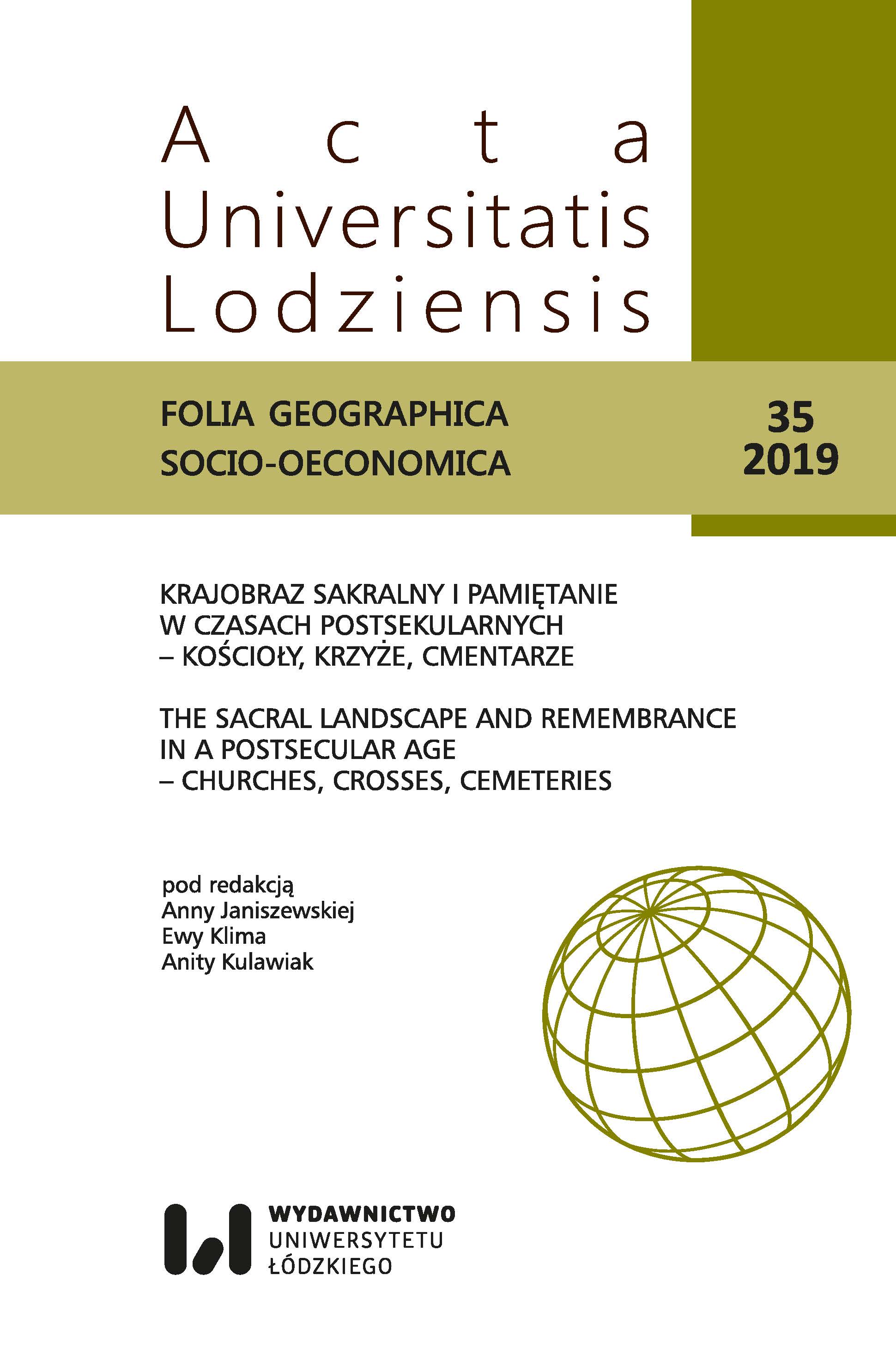Postrzeganie przez dzieci miejsc kultu religijnego na terenach wiejskich Europy Środkowej: studia przypadków na pograniczu czesko-polskim i polsko-słowackim
DOI:
https://doi.org/10.18778/1508-1117.35.02Słowa kluczowe:
percepcja dzieci, miejsca kultu religijnego, obszary wiejskie Europy Środkowej, tożsamość religijnaAbstrakt
Niniejsze opracowanie koncentruje się na badaniu lokalnej tożsamości dzieci mieszkających w małych miastach na pograniczu Czech, Polski i Słowacji. Mapy poznawcze, sporządzane przez uczniów szkół podstawowych w gminach położonych w pobliżu granic państwowych, pozwalają zbadać znaczenie lokalnych miejsc kultu religijnego w umysłach młodych ludzi. Badanie to z powodzeniem analizuje codzienne interakcje między badanymi a ich lokalnym krajobrazem. Ma na celu podkreślenie religijnych elementów tożsamości lokalnej.
Metody zastosowane w badaniach prezentują bardziej humanistyczne i jakościowe podejście, rzucając światło na codzienne doświadczenia dzieci mieszkających na wsi. Mapy szczegółowej lokalizacji miejsc kultu religijnego szkicowane przez dzieci są doskonałym narzędziem na przeniesienie badań poza sferę „oficjalnie sakralną”. Metody te pozwalają również na wymieszanie na mapie elementów zarówno pasywnych (miejsca sakralne na mapie poznawczej), jak i aktywnych, zaliczających dany obiekt religijny do trzech najważniejszych preferencji elementów religijnych, w ramach lokalnej tożsamości terytorialnej.
Niniejsze badanie pokazuje, w jaki sposób dzieci wykorzystują elementy lokalnego krajobrazu religijnego do konstruowania i rekonstruowania tożsamości społecznej. Dwie słowackie gminy wykazały największą sympatię do elementów religijnych. Polskie gminy uplasowały się pośrodku, a dwie czeskie gminy uzyskały najniższe oceny pod względem miejsc kultu religijnego uznanych za ważne dla uczestników badania.
Bibliografia
Bilska-Wodecka E., 2005, Poland. Post-communist religious revival, [in:] Knippenberg H. (ed.), The changing religious landscape of Europe, Het Spinhuis, Amsterdam: 120–144.
Google Scholar
Bilska-Wodecka E., 2006, From multi-confessional to mono-confessional state. State-church relations in Poland following World War II, “GeoJournal”, 67 (4): 341–355.
Google Scholar
DOI: https://doi.org/10.1007/s10708-007-9058-z
Brace C., Bailey A.R., Harvey D.C., 2006, Religion, place and space: A framework for investigating historical geographies of religious identities and communities, “Progress in Human Geography”, 30 (1): 28–43, https://doi.org/10.1191/0309132506ph589oa
Google Scholar
DOI: https://doi.org/10.1191/0309132506ph589oa
Chromý P., Jančák V., Marada M., Havlíček T., 2011, Venkov – žitý prostor: regionální diferenciace percepce venkova představiteli venkovských obcí v Česku [Rural Areas – Living Space: Regional Differencies in the Perceptions of Representatives of Rural Municipalities in Czechia Regarding Rural Areas], “Geografie”, 116 (1): 23–45.
Google Scholar
DOI: https://doi.org/10.37040/geografie2011116010023
Ellard C., 2015, Places of the Heart the Psychogeography of Everyday Life, Bellevue Literary Press, New York.
Google Scholar
European Union (ed.), 2005, Special Eurobarometer 225: Social values, science and technology.
Google Scholar
Hammond P., 1988, Religion and the persistence of identity, “Journal of Scientific Study of Religion”, 27 (1): 1–11.
Google Scholar
DOI: https://doi.org/10.2307/1387398
Hamplová D., 2013, Náboženství v české společnosti na prahu 3. tisíciletí [Religion in the Czech Society on the threshold of the third millennium], Karolinum, Prague.
Google Scholar
Havlíček T., 2014, Development and Transformation of Religious Landscape in Prague after the Fall of Communism, “Prace Geograficzne”, 137: 51–67.
Google Scholar
Havlíček T., Hupková M., 2008, Religious landscape in Czechia: New structures and trends, “Geografie”, 113 (3): 302–319.
Google Scholar
DOI: https://doi.org/10.37040/geografie2008113030302
Havlíček T., Hupková M., 2013, Sacred structures in the landscape: The case of rural Czechia, “Scottish Geographical Journal”, 129 (2): 100–121, https://doi.org/10.1080/14702541.2012.754931
Google Scholar
DOI: https://doi.org/10.1080/14702541.2012.754931
Havlíček T., Hupková M., Smržová, K., 2009, Changes in the geographical distribution of religious heterogeneity in Czechia during the transformation period, „AUC Geographica”, 44 (1–2): 31–47.
Google Scholar
DOI: https://doi.org/10.14712/23361980.2015.61
Havlíček T., Klingorová K., 2018, City with or without God? Features of post-secularism in religious landscape of post-communist Prague, “Social & Cultural Geography”, 19 (6): 789–811, https://doi.org/10.1080/14649365.2017.1312696
Google Scholar
DOI: https://doi.org/10.1080/14649365.2017.1312696
Hemming P.J., Madge N., 2011, Researching children, youth and religion: Identity, complexity, agency, “Childhood”, 19 (1): 38–51.
Google Scholar
DOI: https://doi.org/10.1177/0907568211402860
Henkel R., 2014, The changing religious space of large Western European cities, „Prace Geograficzne”, 137: 7–15, https://doi.org/10.4467/20833113PG.14.006.2151
Google Scholar
King P.E., 2003, Religion and Identity: The Role of Ideological, Social and Spiritual context, “Applied Development Studies”, 7 (3): 197–204, https://doi.org/10.1207/S1532480XADS0703_11
Google Scholar
DOI: https://doi.org/10.1207/S1532480XADS0703_11
Klingorová K., 2016, Feministické geografie náboženství: křesťanství v každodenním životě mladých žen [Feminist geographies of religion: Christianity in everyday life of young women], “Geografie”, 121 (4): 612–631.
Google Scholar
DOI: https://doi.org/10.37040/geografie2016121040612
Očovský Š., 1995, Änderungen der religiösen Struktur der Bevölkerung in der Slovakei im 20. Jahrhundert, [in:] Rinschede G., Vossen J. (eds.), Beiträge zur Religionsgeographie 1995, “Geographia Religionum”, 10: 21–42, Dietmar Reimer, Berlin.
Google Scholar
Pew Research Center (ed.), 2012, The Global Religious Landscape, http://www.pewforum.org/2012/12/18/global-religious-landscape-exec/
Google Scholar
Potančoková M., Berghammer C., 2015, Urban Faith: Religious Change in Vienna and Austria from 1986 to 2013, [in:] Pokorny L., Hödl G. (eds.), Religion in Austria, Volume 2, Praesens, Vienna.
Google Scholar
Reeves D., 2015, Religious themes in Central European postage stamps, 2006–2010, “Journal of Cultural Geography”, 32 (2): 169–194, https://doi.org/10.1080/08873631.2015.1021093
Google Scholar
DOI: https://doi.org/10.1080/08873631.2015.1021093
Tomka M., 2005, Church, State and Society in Central Europe, The Council for Research in Values and Philosophy, Washington, D.C.
Google Scholar
Wikimedia Commons, 2006, Bazilika Navštívení Panny Marie.jpg., https://commons.wikimedia.org/wiki/File:Bazilika_Nav%C5%A1t%C3%ADven%C3%AD_Panny_Marie.jpg. [Accessed 15 Apr. 2017].
Google Scholar
Wilford J., 2010, Sacred archipelagos: Geographies of secularization, “The Sage Handbook of Human Geography”, 34 (3): 328–348, https://doi.org/10.1177/0309132509348558
Google Scholar
DOI: https://doi.org/10.1177/0309132509348558
Zachar Podolinska T., Tížik M., Majo J., 2019, Religiosity in Slovakia: Structure, Dynamics and Spatial Diversification, “Central European Journal of Contemporary Religion”, 1: 1–33, https://doi.org/10.14712/25704893.2019.1
Google Scholar
DOI: https://doi.org/10.14712/25704893.2019.1
Pobrania
Opublikowane
Jak cytować
Numer
Dział
Licencja
Prawa autorskie (c) 2019 Acta Universitatis Lodziensis. Folia Geographica Socio-Oeconomica

Utwór dostępny jest na licencji Creative Commons Uznanie autorstwa – Użycie niekomercyjne – Bez utworów zależnych 4.0 Międzynarodowe.








